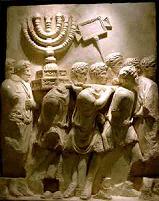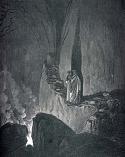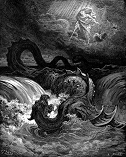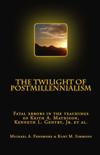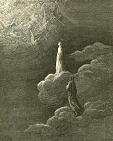The Bottomless Pit
Among the imagery of Revelation, the
bottomless pit holds a prominent place. The locust army bearing
the image of “scorpion-centaurs” emerges from the pit (Rev.
9:1ff). Also, the beast and dragon are shut up in the pit and
rise from thence to make war on the saints (Rev. 11:7; 17:8;
20:1-3; 7-11). Because the pit is central in the imagery of
Revelation, particularly to the millennial binding of the dragon
and beast, it is important that we understand aright the meaning
of this symbol.
Old Testament Origins
The bottomless pit first occurs in Rev.
9:1, 2 where it is portrayed as a great smoking cavern,
debouching smoke and fumes from the bowels of hell:
And the fifth angel sounded, and I saw a
star fall from heaven unto the earth: and to him was given the
key of the bottomless pit. And he opened the bottomless pit; and
there arose a smoke out of the pit, as the smoke of a great
furnace; and the sun and the air were darkened by reason of the
smoke of the pit.
The basic imagery of the smoking furnace
hales from Genesis nineteen and the overthrow of Sodom and
Gomorrah. Scripture
records that God rained fire and brimstone upon the cities of
Sodom and Gomorrah, turning them to ash. In the morning, Abraham
rose up and viewed the place where the cities had been “and lo,
the smoke of the country went up as the smoke of a furnace”
(Gen. 19:28).
The overthrown of Sodom and Gomorrah made a
permanent impression upon the human psyche; all subsequent
literature, pagan and divine, portraying hell as a place of
sulfurous fumes and continuous burnings derives from this
source. Fire and brimstone thus become synonymous with the fate
of the wicked. The basic imagery of Sodom’s overthrow is picked
up and developed in the prophets where it becomes identified
with Sheol (the place of the dead), the pit and destruction.
Concerning the king of Babylon Isaiah writes:
Hell from beneath is moved for thee
to meet thee at thy coming: it stirreth up the dead for thee,
even all the chief ones of the earth; it hath raised up from
their thrones all the kings of the nations…Thy pomp is brought
down to the grave, and the noise of viols: the worm is
spread under thee, and the worms cover thee…all the kings of the
nations, even all of them, lie in glory, every one in his own
house [sepulcher].
But thou art cast out of thy grave like an abominable
branch, and as the raiment of those that are slain, thrust
through with a sword, that go down to the stones of
the pit.”
Isa. 14:9-19, emphasis added
Here, we see that hell (Sheol), the grave, and the pit are closely related and involve the idea of a subterranean realm to which the dead descend. There seems implicit in the language of a “pit” and covering of worms the notion of a mass burial site, similar to the puticuli - corpse-pits - of the Romans, where the bodies of criminals and those killed in the arena were carelessly flung to rot and putrefy. In other passages, the image of a mass funeral pyre is employed. Thus, concerning the destruction of 185,000 soldiers of the Assyrian host by the angel of the Lord, Isaiah wrote:
For through the voice of the Lord shall the
Assyrian be beaten down, which smote with a rod…For Tophet is
ordained of old; yea, for the king it is prepared; he hath made
it deep and large: the pile thereof is fire and much wood; the
breath of the Lord, like a stream of brimstone, doth kindle it."
Isa. 30:31-33; cf. Isa. 37: 36.
Tophet is another name for the valley of
Hinnom (Gehenna) and answers to the lake of fire and second
death (cf. Matt. 10:28; Jam. 3:6;
Rev. 19:20; 20:14, 15) (The Old Testament makes no
distinction between the temporary place of the lost in Sheol and
their permanent destruction in Gehenna).
Tophet/Gehenna was a place outside of Jerusalem’s walls
where the Israelites sacrificed their children to Molech (II
Chron. 28:3, 33:6; Jer. 7:31; 19:2-6); it was later polluted by
Josiah (II King 23:10) and afterwards made a place in which the
refuse of the city was burnt. It was here that the Israelites
buried and burned the 185,000 corpses of the Assyrian host, and
for that reason became identified with the destruction and place
of the lost. In a subsequent chapter, Isaiah refers to
Tophet/Gehenna and the mass burial and cremation of 600,000 Jews
who starved to death during the siege by Titus, saying, “their
worm shall not die, neither shall their fire be quenched” (Isa.
66:24; cf. Mk. 9:44). The bodies of those who died in the siege
were cast into Tophet beyond the city walls where they were
eaten of fire and worms.[1]
In Ezekiel, casting down to the pit (Sheol) is a poetic reference to the destruction of an enemy army or nation. Ezekiel describes the fall of Tyre thus:
“They shall bring thee down to
the pit, and thou
shalt die the deaths of them that are slain in the midst of the
seas” (Ezek. 28:8; emphasis added) Concerning Assyria Ezekiel
said: "I made the nations to shake at the sound of his fall,
when I cast him down to hell with them that descend into
the
pit" (Ezek. 31:16; emphasis added). Other nations described
by Ezekiel as being cast down to the pit also include Egypt,
Elam, Meshec, Tubal, Edom, and Zidon (Ezek. 32:18, 22, 24, 26,
29, 30; cf. Isa. 14:9-23; 30:27-33).
Among the pagan poets and writers, the
similarity of Revelation’s image of hell as a great smoking,
cavernous, furnace is equally pronounced. Thus, Virgil’s Aeneid,
an epic poem of the legendary founding of Rome, describes the
underworld (infernus) as a pit, a deep cave, whose mouth
gapes enormously, fuming up from its black throat lethal fumes
to the vault of heaven, killing any bird that flies through its
vapors. Hell itself has a place of blessing (Elysium) and a
place of torments (Tartarus), engirdled by a burning stream and
flaming torrent (see generally, lines 219-622). That the Greeks
and Romans had partially correct conceptions about the
after-life testifies to mankind’s common heritage; that all men
are derived from a common stock, which, at its genesis, received
certain basic truths about life-after-death that were handed
down from a common source and later corrupted by pagan writers.
In any event, it seems clear that both Jew
and Gentile would have quickly recognized the imagery of
Revelation’s bottomless pit as referring to Sheol or Hades.
New Testament Testimony
The phrase translated “bottomless pit” is
from the Greek phreatos tes abyssou, literally, “pit of
the abyss.” Where the term “abyss” occurs elsewhere in the New
Testament it refers to Hades. Thus, in Luke 8:31, the unclean
spirit in the Gadarean demoniac implored that it not be expelled
into the abyss, or Tartarus, translated in our versions as
“deep.” Similarly, Paul speaks of Christ’s death as involving a
decent to the abyss, saying, “Who shall descend into the deep? [Gk.
abyssos] (that is, to bring up Christ again from the dead)"
(Rom. 10:7).
Peter, in language very similar to
Revelation’s binding the dragon in the pit (Rev. 20-:1-3) -
indeed, its probable source - speaks of “angels” (probably the
sons of Seth that sinned by marrying unbelieving women, Gen.
6:1-4), cast down to Tartarus, reserved under chains of darkness
unto the judgment of the last day (II Pet. 2:4; cf. Jude
6). These same individuals Peter elsewhere refers to as spirits
in prison (I Pet. 3:19). Therefore, Hades Tartarus was not only
represented by the image of a smoking cavern or pit, but a
prison for the lost pending final judgment.
Finally, Rev. 9:11 describes the king of
the locust army by the names of Apollyon (Greek) and Abaddon
(Hebrew), which mean destruction or perdition, also plain
references to sheol. The eighty-eighth Psalm demonstrates best
the relative identity of the pit, Sheol, and Abaddon, or
destruction:
I am accounted with them that go down into
the pit...free among the dead, like the slain that lie in
the grave...Thou hast laid me in the lowest pit, in
darkness, in the deeps...Shall thy loving kindness be
declared in the grave [sheol]? Or thy faithfulness in
destruction [abaddon]?” Ps. 88:4-11; emphasis added.
Thus, by both Old and New Testament
sources, the bottomless pit is a clear reference to Sheol or
Hades.
Significance of Symbology in Revelation
In Revelation, the bottomless pit has a
dual meaning. First,
as the sea is a geographic symbol for the realm of heathendom
(pointing to the Mediterranean world inhabited by the Romans and
Greeks), so the bottomless pit is a spiritual symbol pointing to
these same peoples. They are associated with hell because they
are “aliens from the commonwealth of Israel, and strangers from
the covenants of promise, having no hope, and without God in the
world” (Eph. 2:12). Hence, they have citizenship in hell in the
same way believers have citizenship in heaven (Eph. 2:19; Phil.
3:20; Col. 1:13).
Keys are a symbol of power and authority.
Thus, Jesus has the keys of hell and of death (Rev. 1:18),
pointing to his power over the grave, and the key of David (Rev.
3:7; cf. Isa. 22:22), referring to the head of the king’s house
who alone had power to admit individuals to the presence of the
king, here referring to Jesus’ exclusive power to admit
believers into the presence of
the Father in heaven. The key of the bottomless pit (Rev.
9:1) therefore refers to authority over heathendom embodied in
the Roman empire. The king of the bottomless pit (Rev. 9:11) is
the Roman emperor, specifically, Nero. Nero looses the
abomination of desolation in the form of the Roman legions to
devastate Palestine with sword and famine, portrayed here by the
invasion of the locust army.
The second meaning attached to the
bottomless pit points to Tartarus as a prison for the dead, a
place where the defeated enemies of God were cast down, as we
saw above in Ezekiel.
Rev. 13:3 describes the beast (the persecutor of God's
people) as having received a mortal wound (death blow). Those
who receive such wounds go down to the dead in Sheol, and this
is what happened to the beast. It went down to the bottomless
pit. The dragon went down with it (Rev. 20:1-3). We submit that
this refers to the collapse of the persecution that arose over
St. Stephen. This occurred by the removal of Caiaphas from the
high priesthood, Pilate’s departure from Palestine, and the
conversion of St. Paul about A.D. 37-38. After Paul’s
conversion, Luke reports “Then had the churches rest throughout
Judaea and Galilee and Samaria, and were edified; and walking in
the fear of the Lord, and in the comfort of the Holy Ghost, were
multiplied” (Acts 9:31).
The period of peace and stability
represented by the dragon’s and beast’s confinement in the pit
was enforced by Claudius Caesar’s policy prohibiting persecution
of the church, affording it protection of law (the religio
licita). This same period is represented by the four angels
holding the winds of heaven until the 144,000 were sealed, after
which the Great Tribulation ensued (Rev. 7). Claudius is “he who
lets” and “what withholdeth” of II Thess. 2:6, 7. s long as
Claudius was upon the throne, the church enjoyed the protection
of law. Jews were
banished from Rome for rioting against Christians (Acts 18:2;
Suetonius, Claudius, XXV, 4). Claudius is the angel of Rev. 20:1
which has the key of the bottomless pit to bind the dragon (the
world civil power, imperial Rome), preventing it from
persecuting the church. The thousand years speaks to the
timeless nature of the spirit/hadean realm (cf. Ps. 90:4)
and represents the period between the persecutions. Greco-Roman
notions about hades had it that the dead remained there a
thousand years, after which they were reincarnated to earthly
life. This is exactly what happens with the dragon and beast.
Claudius would be removed and the “man of
sin” and “son of perdition” (Apollyon/Nero) would come to the
throne and the church would come under empire-wide persecution.
This is represented by the beast’s deadly wound being healed
(Rev. 13:3, 14). The beast (and dragon) would rise anew from the
pit to persecute God’s people; a sort of antithesis of Christ’s
resurrection to save his people from sin. The period during
which the dragon and beast were confined to the pit is
described, saying, the beast “was and is not and yet is and
shall ascend out of the abyss” (Rev. 17:8; cf. 11:7).
“Was” points to the earlier persecution under St. Paul; “is not”
points to the period when John wrote during which the
beast/dragon were prevented to persecute the church; “yet is”
points to the fact that Jewish hatred for the church had not
ceased to exist, but was merely repressed – “the mystery of
iniquity” was restrained, but
still at work (II Thess. 2:7). “Shall ascend out of the
abyss” points to the coming eschatological crisis when the beast
would temporarily revive in the persecution under Nero.
Conclusion
The bottomless pit is a reference to the
hadean realm of the lost dead (Tartarus). In Revelation, the pit
is a spiritual symbol of the realm of heathendom over which the
Roman emperors sat as kings, holding the keys to the abyss.
he pit is also a symbol of death and defeat of the
church’s enemies, during the period it is restrained to
persecute the church; viz., from Claudius to Nero.
To receive Kurt Simmons’ e-mail newsletter, The Sword & The Plow, click the Subscribe link:
All rights reserved.
